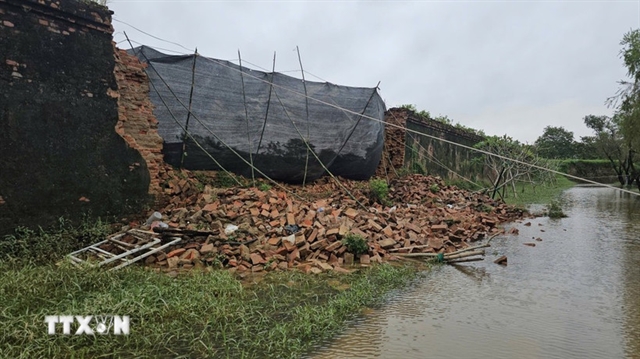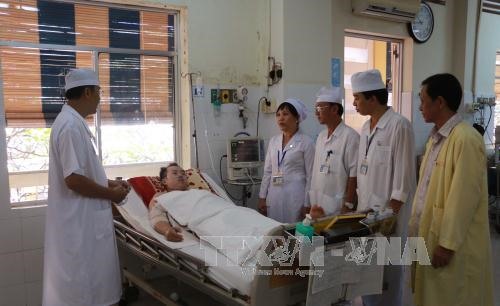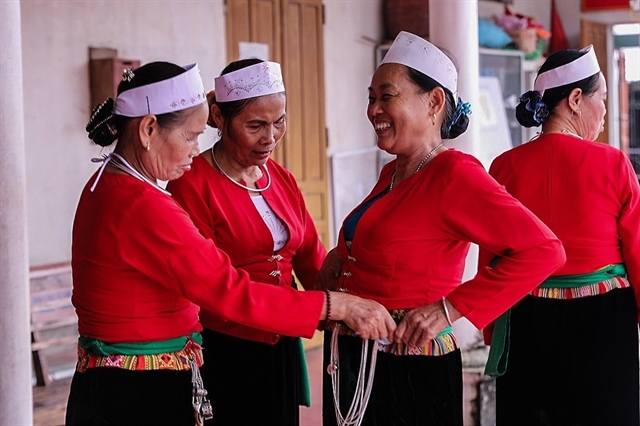 Society
Society

Though Việt Nam has a low fataltity rate among patients with dengue fever, the Ministry of Health has instructed hospitals nationwide to try to further reduce the number of deaths to the lowest possible number.
 |
| Doctors at Sóc Trăng General Hospital treat a patient with severe dengue fever. — VNA/VNS Photo Chanh Đa |
HCM CITY — Though Việt Nam has a low fatality rate among patients with dengue fever, the Ministry of Health has instructed hospitals nationwide to try to further reduce the number of deaths to the lowest possible number.
Nguyễn Trọng Khoa, the deputy head of the ministry’s Medical Examination and Treatment Department, spoke at a conference on treatment of dengue fever held on Wednesday in HCM City.
Khoa said the country, particularly Hà Nội, this year saw a more severe outbreak of dengue fever compared to previous years. There were a total of 181,054 dengue fever cases, an increase of 22.7 per cent compared to last year.
Of these, 30 people died, an increase of nine against last year.
The mortality rate, however, was low compared to other countries in Asia. In 2016, for instance, the rate was 0.033 per cent of all cases in Việt Nam.
Still, it is important to continue to reduce the number of fatalities to the lowest possible number, Khoa said.
Dr Phạm Văn Quang, head of the intensive care department at Paediatrics Hospital 1 in HCM City, said improving the skills of doctors and nurses at provincial hospitals to treat dengue fever was vital to help reduce the number of fatalities.
It would also help reduce the number of patients with severe dengue fever who are transferred to city- or central-level hospitals.
Since last year, the hospital has provided online medical consultations to improve the capacity of doctors and nurses to treat dengue fever at province-level hospitals via smartphones.
The Obstetrics and Paediatrics Hospital in the Mekong Delta province of Cà Mau, for example, took photos and videos of patients and sent blood tests and X-ray results as well as other data to send to Paediatrics Hospital 1 in HCM City for guidance on treating a severely ill patient with dengue fever.
“If the patient had been transferred to the hospital in HCM City and not treated on the spot via smartphones, it would have been dangerous for her because she could have died on the way. It takes 8 hours for a transfer,” he added.
If patients with dengue fever are not treated in time, they can rapidly progress to dengue shock syndrome with severe complications or death, he said.
Last year, four patients were saved by providing online medical consultations via smartphones.
This year, doctors at other province-level hospitals, such as Châu Đốc General Area Hospital, An Giang and Trà Vinh Obstetrics and Paediatrics Hospital, Bến Tre General Hospital and Cần Thơ Paediatrics Hospital, have used this method.
Via smartphones, doctors at city and central-level hospitals can talk directly to families of patients with severe dengue fever and explain why it is necessary to stay at the local hospital for treatment, Quang said.
Many families with relatives diagnosed with severe dengue fever often do not trust the capacity of doctors at local hospitals, but consultation with doctors in bigger cities can relieve their anxiety about the quality of treatment, he added.
Communication between doctors via smartphones can also help reduce patient overcrowding at city and central-level hospitals, such as Paediatrics Hospital 1 in HCM City.
This year, many hospitals in Hà Nội like the National Hospital of Tropical Diseases have been overcrowded, leading to a lower quality of treatment, according to Khoa.
Dr Trương Ngọc Trung, deputy head of the training division for provincial and grassroots hospitals at HCM City’s Hospital for Tropical Diseases, said that doctors and nurses at the hospital need further training in treating dengue fever. — VNS




